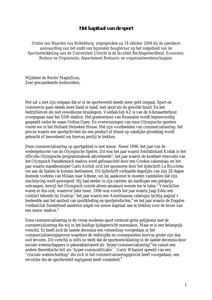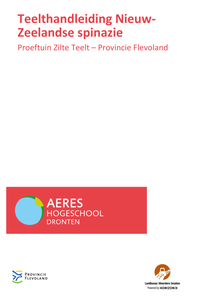For twenty years, typical outdoor lifestyle sports like rafting, snowboarding and rock climbing, which used to be exclusively practised in natural environments, are being offered in controlled artificial settings. This process can be described as 'the indoorisation of outdoor sports'. With this development, questions of authenticity arise. Are these new, commercial forms still authentic lifestyle sports? And can we consider the participants in these indoorised lifestyle sports as authentic? There has been a discussion about authenticity in lifestyle sports since its worldwide popularisation and it is worth to reconsider this discussion against the background of new, commercial versions of lifestyle sports. Therefore, in this paper a qualitative analysis is offered about the consumption of a constructed authenticity in a cultural context increasingly characterized by artificialization.
DOCUMENT
Knowledge valorisation is the transfer of knowledge from one party to another for economic benefit. The concept of valorisation is based on the underlying metaphor of KNOWLEDGE AS A THING. It is the same metaphor that makes it possible to talk about the value of knowledge. If knowledge is like a ‘thing’, then that ‘ thing’ must have a specific value. Value can be defined as the degree of usefulness or desirability of something, especially in comparison with other things, and is by definition subjective. Value is in the eye of the beholder. Any valuation method therefore needs to take into account this subjective nature by deliberately choosing the appropriate ‘standard of value’ (value to whom?) and ‘premise of value’ (value under what circumstances?). There are three ways to determine the value of something of which financial valuation is the most used. In turn financial valuation can be done using a cost approach, a market approach or an income approach. In most cases the income approach is the most appropriate. However, this approach requires a number of assumptions to be made; most of which are impossible to validate. The formulas that are used in the process can be intimidating to non-experts with the danger of disguising the inherent subjective and speculative nature of any valuation of knowledge as a ‘thing’.
DOCUMENT

During the last twenty years, a remarkable new type of service has been developed in the world of sports, which can be described as the indoorisation of outdoor sports. Typical outdoor sports like climbing, skiing, surfing, rowing, and skydiving, which used to be exclusively practiced in a natural environment of mountains, oceans, rivers and the air, are now being offered for consumption in safe, predictable and controlled indoor centers. The present article emphasizes the rise of indoor lifestyle sports, such as rafting, snowboarding, skydiving and surfing. It discusses the conditions under and ways in which commercial entrepreneurs in the Netherlands have created this market, the meanings that they have ascribed to their centers and the dilemmas with which they have been confronted. It is argued that the rise of this economic market cannot be understood if it is solely interpreted as the result of economic, technological or natural developments. These economic activities were also embedded in and influenced by shared understandings and their representations in structured fields of outdoor sports, mainstream sports and leisure experience activities. A better understanding of the indoorisation of outdoor lifestyle sports can be achieved by recognizing how these structures and cultures pervaded the rise of this new market.
DOCUMENT

The purpose of this paper is to reflect on the experiences of safety and security management students, enrolled in an undergraduate course in the Netherlands, and present quantitative data from an online survey that aimed to explore the factors that have contributed to students’ satisfaction with, and engagement in, online classes during the COVID-19 pandemic. The main findings suggest an interesting paradox of technology, which is worth further exploration in future research. Firstly, students with self perceived higher technological skill levels tend to reject online education more often as they see substantial shortcomings of classes in the way they are administered as compared to the vast available opportunities for real innovation. Secondly, as opposed to democratising education and allowing for custom-made, individualistic education schedules that help less-privileged students, online education can also lead to the displacement of education by income-generating activities altogether. Lastly, as much as technology allowed universities during the COVID-19 pandemic to continue with education, the transition to the environment, which is defined by highly interactive and engaging potential, may in fact be a net contributor to the feelings of social isolation, digital educational inequality and tension around commercialisation in higher education.
MULTIFILE

Stakeholders and in particular customers are an important source for business model innovation. Especially for sustainable business models, stakeholder integration may radically change the business logic and help to revise the business model. In this process cognition plays a central role, challenging basic assumptions and changing the dominant logic. In this paper we explore how interactions with the network contribute to making a cognitive shift in development of a sustainable business model. We build on three cases and closely look at the commercialisation stage in which a change of cognition and redesign of the business model take place. Our findings show that network interaction changes the dominant logic in business model innovation in two ways: by triggering a cognitive shift and by contributing to business model redesign. Our main contribution is the conceptualization of three interrelated shaping processes: market approach shaping, product/service offering shaping and credibility shaping. They provide a fine-grained perspective on value creation through collaborative networks and add to the business model literature by providing a framework to study the role of networks and cognition in business model innovation. For practitioners the shaping processes may support business model redesign and building relationships to advance commercialisation of sustainability-oriented innovations.
DOCUMENT

Oratie over het commercialiseringsproces op sportgebied, uitgesproken op 18 oktober 2006 bij de openbare aanvaarding van het ambt van bijzonder hoogleraar op het vakgebied van de Sportontwikkeling aan de Universiteit Utrecht in de faculteit Rechtsgeleerdheid, Economie, Bestuur en Organisatie, departement Bestuurs- en organisatiewetenschappen.
DOCUMENT

The increasing commercialisation of the sports sector and changing consumer demands are some of the issues that create challenges for non-profit sports in contemporary society. It is important for managers and marketers of these organisations to innovate because innovation is a way to grow within a competitive environment and to meet customers' expectations. The present study aims to develop an explorative typology of sports federations based on their attitudes and perceptions of determinants of innovation and their innovation capacity. A cluster analysis suggested three clusters with different responses towards service innovation: traditional sports federations, financially secure sports federations and competitive sports federations. Sports federations perceiving competition in terms of financial and human resources, favouring change and paid staff involvement in decision-making processes, and with negative economic perceptions are significantly more innovative. These findings have implications for the management and marketing of non-profit sports organisations.
LINK
Nieuw-Zeelandse spinazie is een kansrijk gewas voor de teelt op brak (grond)water of op verzilte gronden. Deze teelthandleiding bevat informatie voor telers die geïnteresseerd zijn om met het gewas aan de slag te gaan. Nieuw-Zeelandse spinazie, zilte teelt, proeftuin, landbouw meerdere smaken
DOCUMENT

Part 3 Programming and Activating Cyberparks deals with the variety of ways in which urban public spaces can be reinvigorated through the use of digital media technologies. As is outlined in the introduction to this volume, digital media technologies profoundly shape the use and perception of urban public spaces. Critical observers have noted that digital media may threaten the public nature of our cities and civic spaces. For instance, elsewhere we have described these threats in terms of three Cs: commercialisation, control, and capsularisation (de Lange and de Waal 2013). First, the combination of digital media technologies and consumer culture overlays everyday urban life with a market logic of pervasive customer tracing, quantification, and a vying for attention. Datafication and personalized recommendation services capitalise on our habitual everyday movements in the city, turning them into an ever-expanding string of (potential) customer ‘touchpoints’. This affects the spatial, social and cultural dimensions of almost every realm of urban life, from work to meeting to leisure to travel to home. Visible illustrations include the rapidly changing appearance of high streets in most cities, or the nature and quality of inner-city neighbourhoods coinciding with the popularity of platforms like Airbnb (for more on platforms, see van Dijck et al. 2018). As a result, our polyvocal and frictional public open spaces are being transformed into silent and seamless marketplaces, where public interactions are reduced to commercial transactions.
DOCUMENT

This thesis provides an examination of judgement autonomy of Dutch commercial real estate valuers in relation to client orientation. The valuation of commercial real estate such as offices or retail properties requires in-depth analysis due to its uniqueness by location, building type and usage details. Essentially, a register-valuer is qualified and instructed to assess a property value to one’s best cognitive effort and inform others of this outcome by means of a valuation report. In the Netherlands, concerns over independence risks and client-related judgement risks of valuers have been raised by regulative authorities as the Dutch Central Bank (DNB) and the Dutch Authority for the Financial Markets (AFM). A significant part of these concerns followed the 2008 financial crisis, which appeared to be at least partially driven by unreliable and incomparable valuations of Dutch commercial real estate (AFM, 2014; DNB, 2012; 2015). Among other things, these concerns led to the instigation of the Nederlands Register Vastgoed Taxateurs (NRVT) in 2015. NRVT is a new Dutch central register of valuation practitioners set up in order to improve self-regulation, quality control and compliance of valuation practitioners. Currently, the chamber for commercial real estate valuation holds about 2,000 commercial valuation registrations (NRVT, 2020). The introduction of NRVT, and other measures taken, reflect an instrumental view towards enhancing professionalism of Dutch valuers. This view is based on a systematic orientation to professional conduct in which good practice is primarily objectively determined (Van Ewijk, 2019). However, Wassink and Bakker (2016) point out that individuals make personal choices in order to deal with work complexity. Insight into and reflection on individual choices is part of what is referred to as normative aspects of professionalisation: what norms prevail in individual judgement and decision-making and why (Van Ewijk, 2019). In this regard, insight into judgement reasoning of valuation practitioners may contribute to normative levels of professional development of valuers. The need for such is expressed through community concerns over how individual judgement autonomy may become subdued due to instrumental-driven developments taking place in the sector. The combination of authoritative concerns over professional quality in the Netherlands and lack of (scientific) insight on how client influence affects judgement in valuation practice poses a problem: How may practitioners address client-related judgement bias risks and improve valuation accuracy from this viewpoint, if little is known on how such risks may occur in daily practice? The seemingly scarce scientific insights available in this regard in the Netherlands may also prevent educational programs to adequately address valuer independence and objectivity risks in relevant training programs. In order to address this knowledge gap, the present PhD research examines the following research problem: 169 Summary “How does client orientation affect professional judgement autonomy of commercial real estate valuers in the Netherlands?” The term ‘client orientation’ should be broadly interpreted and may refer to valuers’ perception, understanding and meaning given to alleged, actual or anticipated client-related aspects. Information on such client aspects is not required for the performance of valuation instructions. It should also be noted that this research examines the context of how client orientation may affect valuer judgement reasoning patterns during work practice, yet not its effect in terms of decision on final value opinion.
MULTIFILE
